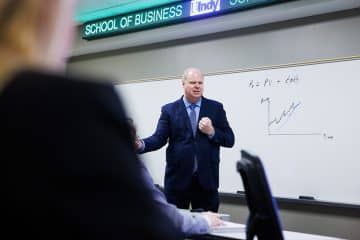What’s Your Education Style? Let’s Decode the Terms
There are so many options for adult students looking to earn a degree. To help you choose the best fit, here are some of the most common terms you’ll run across, and what they mean.
On-campus (Traditional) Classes
On-campus programs require weekly attendance at classes held on a college campus. Think of a typical school setting, with an instructor, a classroom, a whiteboard, and other students. It’s normal for classes like these to meet once a week for a few hours at a time. Some schools offer accelerated programs, where you don’t have to go as often, but the classes you do attend are longer and more intensive.
Online Classes
As an alternative to traditional programs, online classes take place over the Internet, so you don’t have to commute to and from campus. These classes involve readings, quizzes, lecture recordings, and student forums. Professors might live-stream their lectures, too. Sometimes, an online class might require you to go to campus to take a proctored exam; be sure to find out about that before you sign up.
There are two types of online classes, based on how they handle their learning schedule.
1. Asynchronous Classes
Some online classes can happen whenever and wherever you want. This is called asynchronous learning — you do the work on your own time. There may be due dates, tests, or other deadlines to keep you on track, though, so if you’re in an asynchronous class and those details aren’t in the class description, ask an advisor.
2. Synchronous Classes
In other online courses, instruction happens in real time, through interactive live lectures, which are open to discussion, questions, and feedback. This is called synchronous learning.
Accelerated Classes (a.k.a Accelerated Semester)
Some schools offer accelerated classes that meet once a week for several hours. Instead of showing up to classes many times a week, an accelerated class is often longer and more intensive. If you live near the main campus or one of the school’s satellite campuses, this may be an appealing option. Some online courses are also accelerated. Every school has slightly different offerings, so be sure to ask for more details on individual programs.
Hybrid Classes
Hybrid classes combine some online instruction with some on-campus instruction. The ratio of online to on-campus will vary by institution. SUNY Buffalo, for instance, offers “Hybrid-Plus” learning: 80% online, 20% on campus.
A hybrid approach could be really useful depending on what you’re studying. For example, a science student could complete experiment requirements in a lab on campus, while completing the rest of their coursework from somewhere else, on their own time.
Competency-Based Education (CBE)
CBE prioritizes competency over theory. These courses measure and advance your individual skill level — giving you credit for what you can do rather than just the theory you know.
Compare that to a typical course, where the syllabus lays out the information you’re going to learn, the class surveys the topic, periodic tests measure your progress toward those learning goals, and your grade is the percentage of the survey you’ve retained. For example, a grade of 80% means you’ve retained 80% of the course’s material.
CBE classes take a different approach. Students learn one foundational skill at a time, then move on. Each skill builds towards a larger, more complex goal of competency in a certain area.
Learning to drive a car with a manual transmission is a good example. Changing lanes and navigating traffic safely are fundamental driving skills, so you might want to get these skills down in an automatic first. Afterward, you could practice on a manual, adding the skill of shifting gears to the skills you’ve already mastered.
With this approach, CBE can even help you finish your degree sooner. Learn more about CBE here.
Bachelor’s Degree
Colleges and universities award bachelor’s degrees to students who successfully complete an undergraduate program. Most of the course types listed here at Abound Finish College are for bachelor’s programs. The Bachelor of Arts (B.A.) and Bachelor of Science (B.S.) are the most common degrees of this type.
Graduate Degree
If you’re interested in further education, a master’s degree is the next step after getting your bachelor’s. Only students who have completed an undergraduate program can enter such a program, also called a graduate degree.
Dual Degree
Many schools offer programs where you can work on two different degrees simultaneously. Usually, the degrees offered are in similar subjects, but not always. Students spend 2–3 years in each program before earning two degrees. Here are a few of the most common combinations:
- Associate’s and bachelor’s
- Dual bachelor’s degree
- Dual bachelor’s with master’s degree
- Dual graduate degree programs (a combination of D.D.S., D.O., M.A., M.D., M.P.P., M.S., J.D., M.B.A., M.P.H., or Ph.D.)
More About Abound: We’re here to help. Abound: MBA narrows down your options and gets you in touch with schools that we can confirm are Accessible, Affordable, Accelerated, and Advanced. Take a look at the schools we trust and find the program that works for you.





